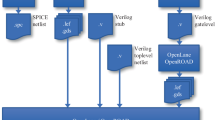Abstract
This paper presents a fast configurable automatic gain control (AGC) with strong focus on fast acting control and low power consumption. This AGC includes two paths, main amplification path and gain adjusting path. Using the gain adjusting path through an extra amplifier provides a way for tracking and comparing the input signal with four adjusted thresholds to be judged for selecting the appropriate gain value for main amplification path. This mechanism of gain control is done by reorganization of input level and changing the resistance of feedback in main amplification path to generate smooth variation gain, without any interruption or delay in signal flow through the variable gain amplifier. Moreover, in order to protect the user from intense transients in variations of the input signal level, output level of variable gain amplifier is directly monitored using optimum threshold to reduce the overall gain using feedback control mechanism. The minimum power is consumed by gain adjusting path has almost no considerable on power consumption, it greatly improves hearing quality. Meanwhile, using a large size PMOS differential pair at the input improved the noise performance. Proposed AGC designed and simulated in TSMC 130-nm CMOS process. The post layout simulation results the maximal SNR is 84.6 dB in 100 Hz–19.6 kHz band-width and the total consumption power of this AGC is 78 μW at 1 V supply voltage. In addition, its gain is varied smoothly between 20 to 57 dB. Achieved results demonstrate that designed AGC meet the requirement of analog front end of hearing aids.














Similar content being viewed by others
References
Baker, M. W., & Sarpeshkar, R. (2006). Low-power single-loop and dual-loop AGCs for bionic ears. IEEE Journal of Solid-State Circuits, 41(9), 1983–1996.
Faheema Mahomed-Asmail, Anel Le Roux, Claude Laurent, "Fitting Hearing AIDS: Clinical & Practical A," http://www.entdev.uct.ac.za.
Devis, T., and Manuel, M. (2018). “Multirate and Filterbank Approaches in Digital Hearing Aid Design: A Review,” in IOP Conference Series: Materials Science and Engineering, vol. 396, no.1.
Haerizadeh, S., Jorgensen, I. H. H., Marker-Villumsen, N., and Bruun, E. (2015). “Investigation of an AGC for audio applications,” in 2015 11th Conference on Ph.D. Research in Microelectronics and Electronics, PRIME 2015, pp. 145–148.
Li, F., Yang, H., Liu, F., and Yin, T. (2011). “A current mode feed-forward gain control system for a 0.8 v CMOS hearing aid,” J. Semicond., vol. 32, no. 6.
Chen, C., and Chen, L. (2019). “A 79-dB SNR 1.1-mW Fully Integrated Hearing Aid SoC”, Circuits, Syst. Signal Process., vol. 38, no. 7, pp. 2893–2909.
Dai, L., and Chen, C. (2016). “A 69-dB SNR 89- μ W AGC for Multifrequency Signal Processing Based on Peak-Statistical Algorithm and Judgment Logic,” VLSI Des., vol. 2016.
Lin, C. W., Liu, Y. Z., and Hsu, K. Y. J. (2004). “A low distortion and fast settling automatic gain control amplifier in CMOS technology,” in Proceedings - IEEE International Symposium on Circuits and Systems, vol. 1.
Cheng, X., Xie, G., Zhang, Z., & Yang, Y. (2014). “Fast-settling feedforward automatic gain control based on a new gain control approach”, IEEE Trans. Circuits Syst. II Express Briefs, 61(9), 651–655. https://doi.org/10.1109/TCSII.2014.2331097
Elwan, H. O., Tarim, T. B., & Ismail, M. (1998). Digitally programmable dB-linear CMOS AGC for mixed-signal applications. IEEE Circuits and Devices Magazine, 14(4), 8–11. https://doi.org/10.1109/101.708487
Elwan, H. O., and Ismail, M. (2000). “Digitally programmable decibel-linear CMOS VGA for low-power mixed-signal applications,” IEEE Trans. Circuits Syst. II Analog Digit. Signal Process., vol. 47, no. 5, pp. 388–398, doi: https://doi.org/10.1109/82.842107.
Elwan, H., El Adawi, A., Ismail, M., Olsson, H. K., & Soliman, A. (1999). Digitally controlled dB-linear CMOS variable gain amplifier. Electronics Letters, 35(20), 1725–1727. https://doi.org/10.1049/el:19991193
Elwan, H., Soliman, A. M., and Ismail, M. (2001). “A CMOS Norton amplifier-based digitally controlled VGA for low-power wireless applications,” IEEE Trans. Circuits Syst. II Analog Digit. Signal Process., vol. 48, no. 3, pp. 245–254, doi: https://doi.org/10.1109/82.924067.
Alegre Pérez, J. P., Calvo, B., and Celma, S. (2010). “A high-performance CMOS feedforward AGC circuit for a WLAN receiver,” IEEE Trans. Ind. Electron., vol. 57, no. 8, pp. 2851–2857, doi: https://doi.org/10.1109/TIE.2009.2036021.
Amini, J., Hendriks, R. C., Heusdens, R., Guo, M., & Jensen, J. (2020). Spatially Correct Rate-Constrained Noise Reduction for Binaural Hearing Aids in Wireless Acoustic Sensor Networks. IEEE/ACM Trans. Audio Speech Lang. Process., 28, 2731–2742.
Lee, Y. C., Chi, T. S., & Yang, C. H. (2020). A 2.17-mw acoustic dsp processor with cnn-fft accelerators for intelligent hearing assistive devices. IEEE Journal of Solid-State Circuits, 55(8), 2247–2258.
Richelli, A. et al. (2018) “A survey of low voltage and low power amplifier topologies,” J. Low Power Electron. Appl., vol. 8, no. 3.
Hoi-Jun Yoo, Chris van Hoof," Bio-Medical CMOS ICs",Springer Science+Business Media, LLC 2011.
López-Martín, A. J., Baswa, S., Ramirez-Angulo, J., & Carvajal, R. G. (2005). Low-voltage super class AB CMOS OTA cells with very high slew rate and power efficiency. IEEE Journal of Solid-State Circuits, 40(5), 1068–1076.
Gregorian, R. (1999). Introduction to CMOS OP-AMPs and Comparators. John Wiley & Sons, Inc.
Chen, L. M., et al. (2015). A 1-V, 1.2-mA fully integrated SoC for digital hearing aids. Microelectronics J., 46(1), 12–19.
Chilukuri, M., and Jung, S. (2019) “A mixed-mode variable gain amplifier for hearing aid devices,” in Proceedings of the 2018 IEEE Dallas Circuits and Systems Conference, DCAS 2018.
Author information
Authors and Affiliations
Corresponding author
Additional information
Publisher's Note
Springer Nature remains neutral with regard to jurisdictional claims in published maps and institutional affiliations.
Rights and permissions
About this article
Cite this article
Koozehkanani, R.D., Makouei, S. & Toofan, S. A fast configurable AGC for front-end of digital hearing aids. Analog Integr Circ Sig Process 109, 367–377 (2021). https://doi.org/10.1007/s10470-021-01921-z
Received:
Revised:
Accepted:
Published:
Issue Date:
DOI: https://doi.org/10.1007/s10470-021-01921-z




